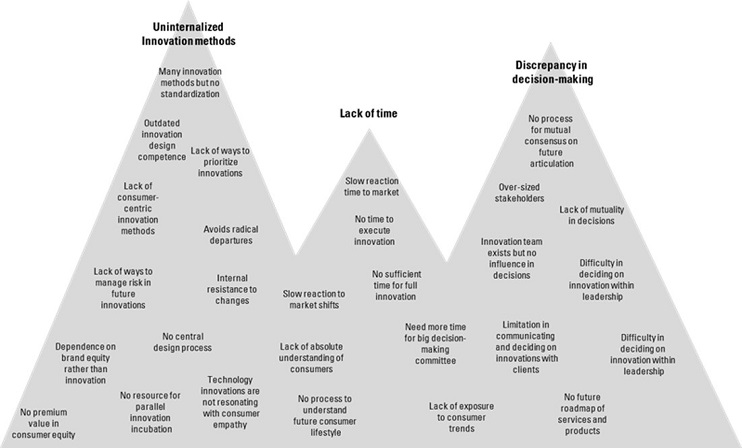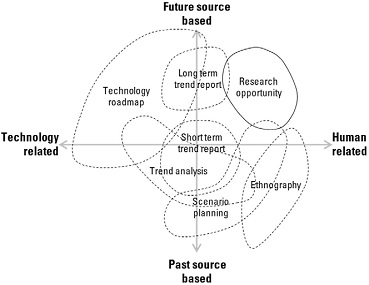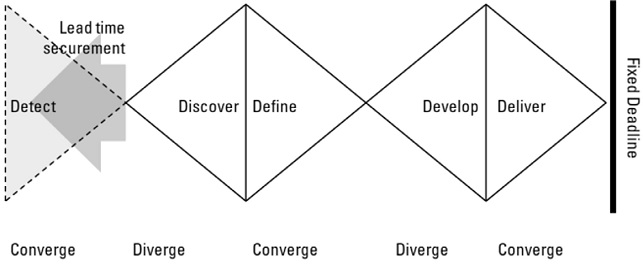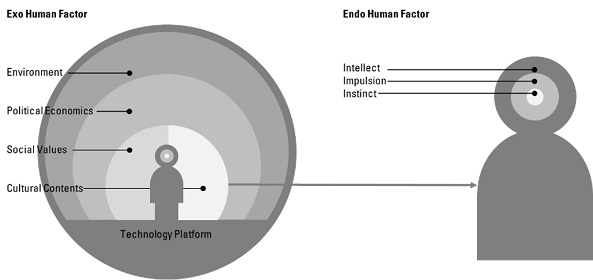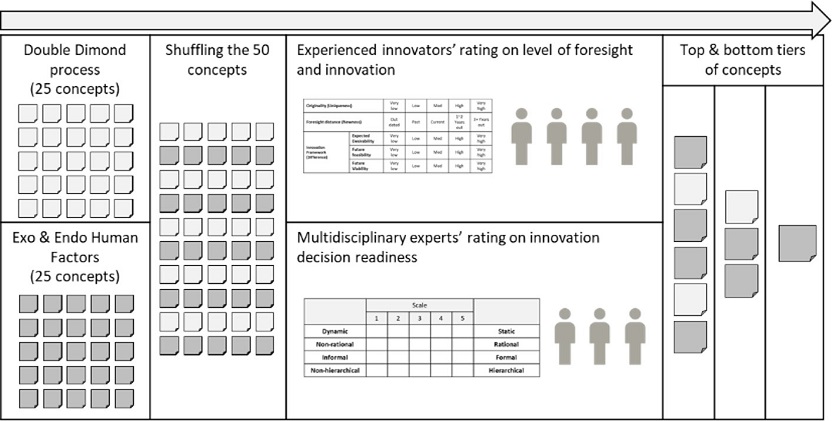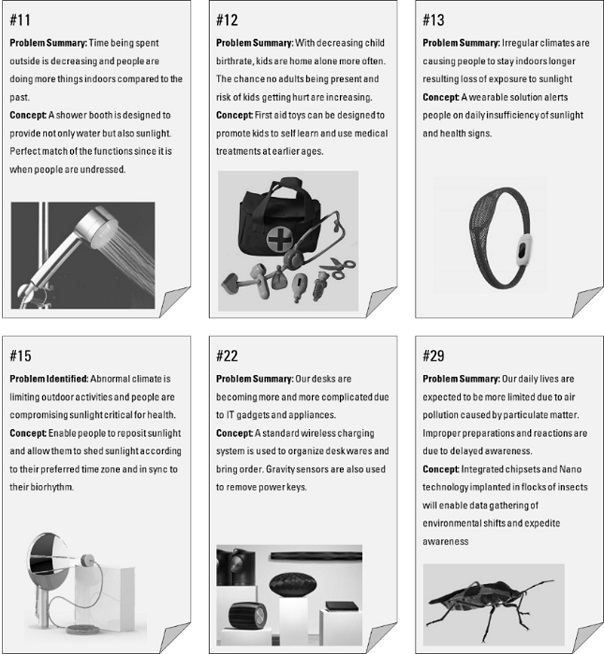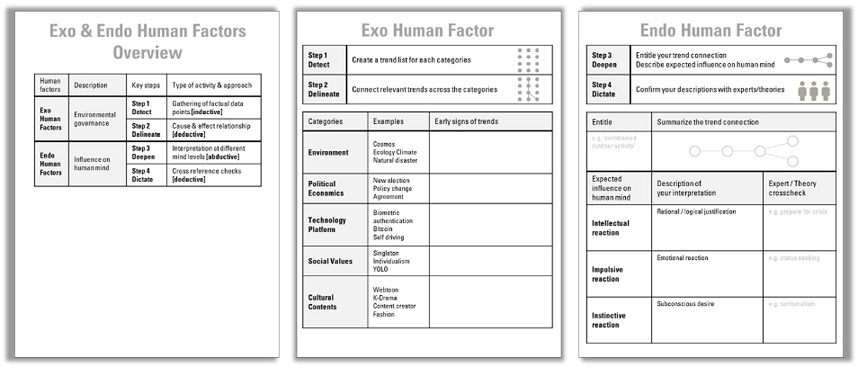
A Design Process for Next-generation Products: Securing Leadtime and Multilateral Inferences through Exo and Endo Human Factors
Background When making business-critical decisions in future consumer innovations, very few methods have a true influence on stakeholders. A well-known weakness of current future innovation methods is the lack of multidisciplinary resonance since a true future innovation does not carry consumption data – inductive reasonings - nor predefined patterns of consumption – deductive reasonings - as primary sources. As a result of not being able to acquire future decisions early on, companies with insufficient lead time have challenges in planning and realizing future innovations.
Methods To promote and influence multidisciplinary stakeholders’ decision making, a future innovation process was composed featuring a full cycle of three types of reasoning: deductive, inductive, and abductive. Based on unpaired groups of concepts generated from the proposed process and a general process in comparison, the conclusive effectiveness of the processes was evaluated by industry experts in terms of innovation decision readiness.
Results The proposed innovation process resulted in improvements in the levels of assurance, structuredness and decision influence. However, there had been a compromise in the level of objectivity due to reduced immediate empathy.
Conclusions By structuring a process to reinforce the articulation and defensibility of the appropriation of future innovation based on diverse reasonings in a multidisciplinary context, the proposed process has shown improvements in key attributes of the outcomes that contribute to decision making in future innovations, while simultaneously allowing more lead time due to early decisions independent of prior references or emerging signs of consumption.
Keywords:
Exo and Endo Human Factors, Future Innovation, Inductive, Deductive, Abductive, Lead Time1. Introduction
Although emergence of design and innovation methods play a critical role in eliciting people centricity and future prediction, few methods are engaged in actual decision making in consumer businesses (Kolko, 2018; Lee, 2018; Kumar, 2013; Bertero, 2015).
Organizations like Advanced Innovation Design Approach -during Innovation Process 4.0 project held by University of Applied Sciences Offenburg and 10 German companies - and D-School at Stanford University - during design thinking boot camp: from insight to innovation - have put forward and demonstrated design activities in context of future innovations, but there are still ways to go before establishing a standard process for future innovation in consumer industry.
The purpose of this study is to retrieve necessary knowledge and construct a process that has multilateral rationales which can be effective for obtaining multidisciplinary decisions in future predictions of consumer industries - hence securing sufficient lead time for innovation realization in the front-end process of new product developments.
Therefore, with proper implementation of the method proposed – Exo and Endo Human Factors – and its linear adaptiveness, the research expectation is to increase chances of standardizing it as the future innovation method for consumer industries.
1. 1. Background Research
As to identify key challenges in practicing future innovation, sixteen small to major companies in local and global consumer businesses were interviewed. The interviews were held based on four key areas - innovation elicitation, project selection, ways of working, and impact – based on MINT framework (Nilsson, Regnell, Larsson & Ritzén, 2010) with focus on execution of innovation.
Three frequent areas – uninternalized innovation methods, lack of time for innovation, and discrepancy in innovation decision-making - were identified through bottom up sorting of key insights from the field interviews (Figure 1).
Literature research was done on commonly used methods for future innovation in consumer industries – electronics, apparel, luxury, and automotive manufacturing. Six methods were identified as the common methods in future innovation.
- (1) Technology roadmap is considered the most popular future forecasting method in high tech consumer industries (Oliveira & Rozenfeld, 2010; Petrick & Echols, 2004). Though it comes across as a method that has high accuracy in future projections, it functions more as a way of setting feasible goals for engineering development and commercialization based on past progression curves than actual forecasting.
- (2) Short-term trend forecasting report provides consumer implications of next 1~2 years based on macroscopic and microscopic trends (Akhil, 2015; Kim, Fiore & Kim, 2013) though - it being commonly provided by business-to-business vendors and suppliers in addition to trend firms - it’s content often reflects upon competitive business directions under development hence making it an influential benchmark in future decisions.
- (3) Trend analysis is a mathematical method capable of offering future trajectory based on prior data patterns (Immerwahr, 2004). Though, when mismanaged – used in incomplete form - it can readily cause misleading results. Since it is a continuum of immediate past, it may not leave much room for innovation lead time. Also, evolutionary predictions post radical shift can depart from actual future.
- (4) Long-term trend forecasting report represents high-level and macroscopic paradigms – e.g. economy, politics etc. – and is commonly used as inspirations for future visions and directions (Akhil, 2015; Keiser & Garner, 2012). Generally, it is less engaged in critical decision making in product and service businesses.
- (5) Scenario planning originates from military based on system of information and trained decoders (Gausemeier, Fink & Schlake, 1998). Nowadays it is utilized informally - without proper regulation - in industries resulting substandard results and low credentials (Mendonça, Cunha, Ruff, & Kaivo-oja, 2009).
- (6) Ethnography evolves from anthropology and social science research. In industries, it is used in more concise and expedited manner especially as a way to compensate conventional consumer research in preventing bias, inertia and consciousness (Schaeffer, 1995).
Overall, technology roadmap is broadly used in technology and consumer industries since it works as an accurate and mutually agreed future target for engineering developments despite its disconnection with human relevance or implications. Short term trend report is also a popular research but lacks in securing lead time due to its nearsightedness. The other methods are generally used in consumer industry for inspirational sessions, but do not carry strong influence in decision making (Figure 2).
Based on the background research, two critical shortcomings of the existing methods were identified: barrier in decision-making due to lack of multidisciplinary communication and understanding, and insufficient time to apply innovation in products.
1. 2. Objective and Scope
(1) Enhancing multidisciplinary resonance in innovation decision-making via application of a full cycle of multilateral inferences – deductive, inductive, and abductive – in a single process which correlates to retention of stakeholders’ attention in diverse fields (Table 1)
(2) Securing an advanced start via earlier detection of future trends - hence gaining more lead time for innovation incubation – independent of existence of consumption data (Figure 3).
2. Hypothesis
2. 1. Exo and Endo Human Factors
Exo and Endo Human Factor method was optimized in terms of structure and description towards ease of understanding and use through a pilot trial of four weeks (Figure 4).
Exo human factor is a group of causes governing human body and is applied over the first few steps of 4 step procedure - detect, delineate, deepen, and dictate - which overarches Exo and Endo human factors (Figure 5).
Step 1: ‘Detect’ is where participating method users brainstorm and investigate trends that fall under the following five causes – that were revised for improved comprehension in the pilot trial originating from PESTEL analysis framework - i.e. political, economic, sociological, technological, environmental, and legal factors.
(1) Environment: e.g. universe, ecology, climate, natural disaster, air pollution etc.
(2) Political economics: e.g. new election, policy changes, trade agreements, political relationships etc.
(3) Technology platform: e.g. biometric authentication, Bitcoin, self-driving, generation of telecommunication etc.
(4) Social values: e.g. singleton, individualism, family values, child development values etc.
(5) Cultural contents: e.g. webtoon, drama, content creators, fashion, art, media etc.
Step 2: ‘delineate’ is where method users establish relationships between trend insights and keys in webbed structure gravitating towards social values and cultural contents which are intimate and influential in human life. Once topologies are created - which may share common trend data points - each thread of topology should represent a future topic.
Endo human factor is the other phase of interpretation on human reflections triggered by the governing causes of Exo human factor. There are three layers of interpretation – intellect, impulsion and instinct that are defined based on the theory of cerebral cortex, limbic system and reptilian brain from a brain structure theory (MacLean, 1990) - which are converted to general terms for accessibility and ease of use (Figure 5).
Step 3: ‘Deepen’ is where method users select topics from step 2 ‘delineate’ and translates them into human reflections and reactions. An important point in this step is to make sure interpretations surpass intellectual reactions and are made at impulsive and instinctive levels as well which may differ from intellectual interpretations. When interpretations are different by levels, generally instinctive and impulsive interpretations in order would override intellectual interpretations. E.g. if fossil fuel is diminishing, intellectually people should drive smaller cars, but impulsively and instinctively people purchase bigger cars.
Step 4: ‘Dictate’ is where cognitive science, anthropology, and/or market experts, and related theories are brought in to readily crosscheck the layered interpretations made in Deepen leveraging deductive inferences and making the final outcome more resonant and defensible for multidisciplinary and higher-level decision makers.
After walking through 4 steps of Exo and Endo Human Factors, naturally the process facilitates method users to step through a cycle of all forms of reasoning rather than relying on fewer types of inferences (Table 2).
2. 2. Demonstration and Validation
Total of 50 concepts were developed by selective students (3rd or 4th year in industrial design major with grade B and above). The first half of the students used Double Diamond process – by Design Council in 2004 - and the second half used Exo and Endo human factors in parallel workshops of 12 weeks in mirroring sequences (Figure 6).
Once the concepts were produced via Double Diamond and Endo and Exo Human Factors, they were shuffled prior to expert assessments eliminating any biases based on the methods. Two parallel tracks of assessments were done to understand – first - the innovativeness which includes foresightedness and future viability directly related to the research objective of lead time securement, and – second - the innovative decision-readiness which includes objectivity and level of influence in decision making directly related to the research objective of multidisciplinary resonance.
As to emulate industry practice, the assessment for level of innovativeness was set-up with 4 designers with an average of 12 years in fields of corporate design and innovation holding master’s degree or above. With 5-point scale, five questions were composed based on NUD - New, Unique and Different - and IDEO’s innovation framework - Desirability, Viability and Feasibility - commonly used in consumer industries (Table 3).
In the assessment for level of innovation decision readiness, a framework from Department of Machine Design, The Royal Institute of Technology, Stockholm, Sweden was utilized with bipolar scales of 5-point measurement, and 3 experts from multidisciplinary backgrounds – engineering, user experience and product planning - with an average 13 years of corporate experiences were recruited (Table 4).
3. Result and Discussion
3. 1. Level of innovativeness
The 4 experts evaluated the concepts based on the index of innovativeness. Overall, there were noticeable enhancements in ‘Foresight Distance’ (+11.2%) which has direct relation to innovation lead time. Also, in IDEO’s innovation framework, average of 9.53% increase was achieved and amongst the increase, ‘Future Viability’ has shown exceptional 12.9% improvement. On the other hand, ‘Originality’ was one category that decreased 3.2% with broader distribution (+0.24 in standard deviation) which was not a surprise since relatively narrower topics are defined and given from the beginning when demonstrating Exo and Endo Human Factors (Table 5).
Based on the results, three potential areas of improvements can be discussed. Firstly, being able to extend foresightedness, in return, the equivalent amount of lead time can relatively be pulled in as well – which is expected to allow additional time for unfamiliar execution of innovations. The effect in this area was cross confirmed, since two thirds of the developed concepts with highest scores in ‘Foresight Distance’ were the outcomes of Exo and Endo Human Factors
Secondly, there were less freedom in the scope of exploration but higher concentration with Exo and Endo Human Factors – which is a double-edged consequence. Hence, there will be less chance of stumbling upon unintended and unique ideas but within limited time in industrial practices, driving focus will likely be beneficial. Though the numeric loss of the result of ‘Originality’ was minor, there were other qualitative signs in the outcomes of the concepts where enhanced guidance of the research topics limited out-of-box concepts and freestyle thinking.
Thirdly, the viability of the future concepts was the most significant improvement. The numeric improvement of ‘Future Viability’ was the highest and the related concepts also carried clearer background justifications in critical conditions - e.g. survival or unavoidable circumstances - based on qualitative evaluation of the concepts by the experts.
3. 2. Level of innovation decision readiness
The results in innovation decision readiness which is in relation to multidisciplinary resonance showed overall positive turnouts. ‘Level of objectivity’ showed 9.2% increase with more condensed standard deviation which has the highest relevance to multidisciplinary resonance. The ‘procedural structuredness’ and ‘influence in top decision making’ have also shown 7.4% increase in average. But ‘level of assurance’ has dropped 2.8% which was not unexpected since foresightedness would naturally accompany less familiarity (Table 6).
Three key discussions can be made base on the numeric and qualitative evaluations from the experts. Firstly, the method of Exo and Endo Human Factors has shown signs of pushing the boundaries but at the same time losing assurance which is a natural compromise. The concepts have presented radical ideas in solving future problems, but due to alienation from general commonality, they have shown low results in current state of assurance. Secondly, the ‘Level of Objectivity’ noticeably improved based on the test results and in qualitative feedback regarding the rationales behind the concepts which were in forms of diverse types of reasoning – inductive, deductive, and abductive. Thirdly, reinforcement in organizational compatibility - with higher chances of becoming a standard method for industries - can be stated based on the improvements shown in the numeric results from the ‘Level of Procedural Structuredness’ and the ‘Level of Influence in Top Decision Making’ as well as the qualitative evaluations of the concepts supported by constructive rationales based on environmental, economic and social shifts.
3. 3. Concept Key Summary
Content wise, there were 6 common concepts out of top several concepts with highest scores from both the measurements in level of innovativeness and innovation decision readiness – despite the fact that the two measurements were based on different index categories and experts – resulting strong cross-confirmation (Figure 7).
3. 4. Linear Toolkit
Overall, test results have shown that Exo and Endo human factors have obtained noticeable performance increase especially in the attributes directly related to the securement of innovation lead time and the multidisciplinary resonance. There were subtle losses in originality and assurance due to the nature of early predictions.
To vitalize use of the method, a tool kit was created providing an overview description and a few work sheets. The first sheet explains how Exo and Endo human factors are broken down to linear 4 steps and definitions. The second page – the first worksheet - provides instructions on step 1 and 2, and examples of the categories. The third page – the second worksheet – provides instructions on step 3 and 4, and templates for the three levels of interpretations (Figure 8).
4. Conclusion
The means of research was to set up a future innovation process that has higher chances of becoming a standard method for business decisions in consumer industries. With diverse rationales that have higher chances of resonating with multidisciplinary decision makers in a company, and hence by improving multidisciplinary consensus on future innovations with multilateral inferences, companies are expected to obtain an earlier start and secure more time for discovering and realizing innovations.
In terms of next steps for Endo and Exo Human Factors, the following areas can be considered as to make the method more impeccable. Since industries and businesses have fixed resources, derivative methods of Endo and Exo Human Factors that are scalable can be more effective especially for smaller businesses. Also, many companies are accustomed to future implications at intellectual level but ways to train leaderships to interpret future at impulsive and instinctive levels can be a good balance to current general practices. Finally, this method was composed based on product development, but it can be researched and versioned to be more effective in other industries as well – e.g. the Forth Industrial Evolutions, service industries etc. – seeking broader applications and standardizations.
Acknowledgments
This content is recomposed based on the research of 2019 PhD dissertation of Sung-Gul Hwang – ‘Systematizing a Method on Early Detection Prior to Signs of Consumption in New Product Developments’ at Yonsei University, Seoul Korea.
Notes
Copyright : This is an Open Access article distributed under the terms of the Creative Commons Attribution Non-Commercial License (http://creativecommons.org/licenses/by-nc/3.0/), which permits unrestricted educational and non-commercial use, provided the original work is properly cited.
References
- Akhil, J. K. (2015). Fashion Forecasting. Seattle, Washington: Create Space.
-
Berterö, C. (2015). Developing qualitative methods - or "same old wine in a new bottle". International Journal of Qualitative Studies in Health and Well-being, 10.
[https://doi.org/10.3402/qhw.v10.27679]

- Double Diamond. (2020). Design Council. Retrieved July, 2020, from https://www.designcouncil.org.uk/news-opinion/what-framework-innovation-design-councils-evolved-double-diamond.
-
Gausemeier, J., Fink, A., & Schlake, O. (1998). Scenario management: An approach to develop future potentials. Technological Forecasting and Social Change, 59(2), 111-130.
[https://doi.org/10.1016/S0040-1625(97)00166-2]

- Hwang, S. -G. (2019). Systematizing a Method on Early Detection Prior to Signs of Consumption in New Product Developments. (Doctoral dissertation). Yonsei University, Seoul.
- IDEO innovation framework - Design Thinking. (2020). IDEO. Retrieved August, 2020 from https://www.ideou.com/pages/design-thinking.
- Immerwahr, J. (2004). Public Attitudes on Higher Education: A Trend Analysis, 1993 to 2003. Public Agenda Foundation.
- Keiser, S. J., & Garner, M. B. (2012). Beyond Design: The Synergy of Apparel Product Development. A&C Black.
- Kim, E., Fiore, A., & H. (2013). Fashion Trends: Analysis and Forecasting. Berg.
-
Kolko, J. (2018). The divisiveness of design thinking. ACM Interactions, 25(3).
[https://doi.org/10.1145/3194313]

- Kumar, V. (2012). 101 Design Methods. New Jersey: John Wiley & Sons Inc.
- Laurel, B. (2003). Design Research Methods and Perspectives. The MIT Press.
- Lee, V. (2018). Design Thinking Is a Boondoggle. The Chronicle of Higher Education.
- MacLean, P. D. (1990). The triune brain in evolution: Role in paleocerebral functions. Springer Science & Business Media.
-
Mendonça, S., Cunha, M. P. E., Ruff, F., & Kaivooja, J. (2009). Venturing into the Wilderness. Long Range Planning, 42(1).
[https://doi.org/10.1016/j.lrp.2008.11.001]

- NUD framework. (2020). Abbreviations. Retrieved August, 2020, from https://www.abbreviations.com/term/125951.
-
Oliveira, M. G., & Rozenfeld, H. (2010). Integrating technology roadmapping and portfolio management at the front-end of new product development. Technological forecasting and social change, 77(8), 1339-1354.
[https://doi.org/10.1016/j.techfore.2010.07.015]

- PESTLE analysis. (2020). CIPD. Retrieved March, 2020, from https://www.cipd.co.uk/knowledge/strategy/organisational-development/pestle-analysis-factsheet.
-
Pink, S. (2007). Doing Visual Ethnography. London: Sage Publications.
[https://doi.org/10.4135/9780857025029]

- Schaeffer, J. H. (1995). Videotape: New Techniques of Observation and Analysis in Anthropology. Berlin: Mouton de Gruyter.
- Thorsten, L. (2006). Technologie Road map: strategisches und taktisches technologie management. Fraunhofer-IRB-Verlag.
-
Wasson, C. (2000). Ethnography in the Field of Design. Human Organization, 59(4), 377-388.
[https://doi.org/10.17730/humo.59.4.h13326628n127516]

